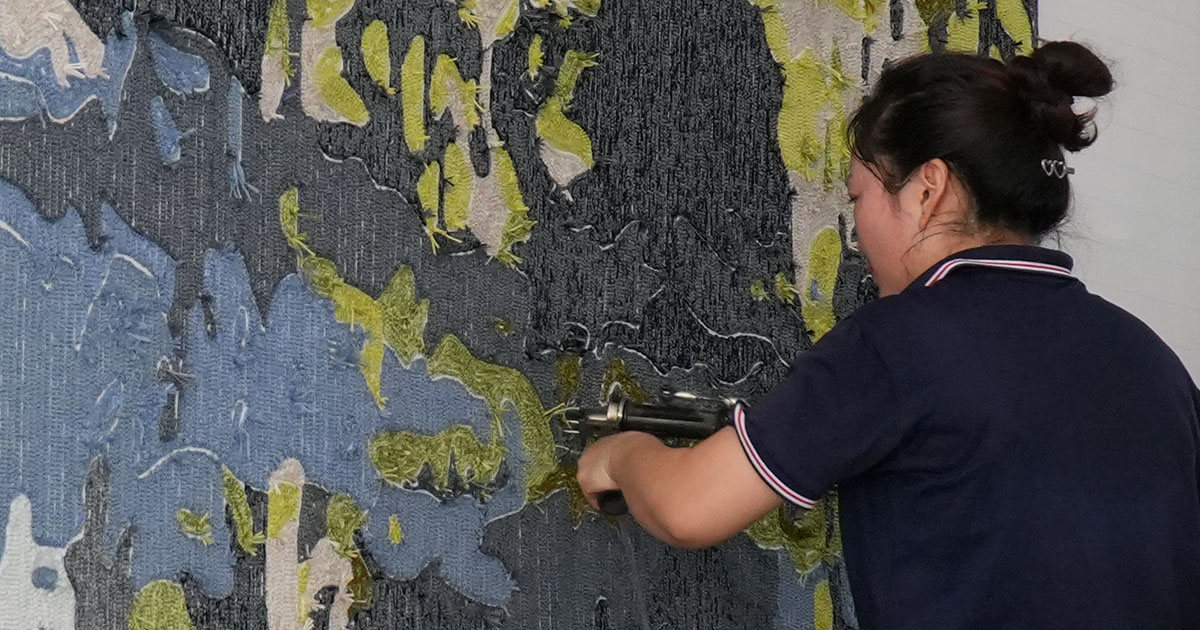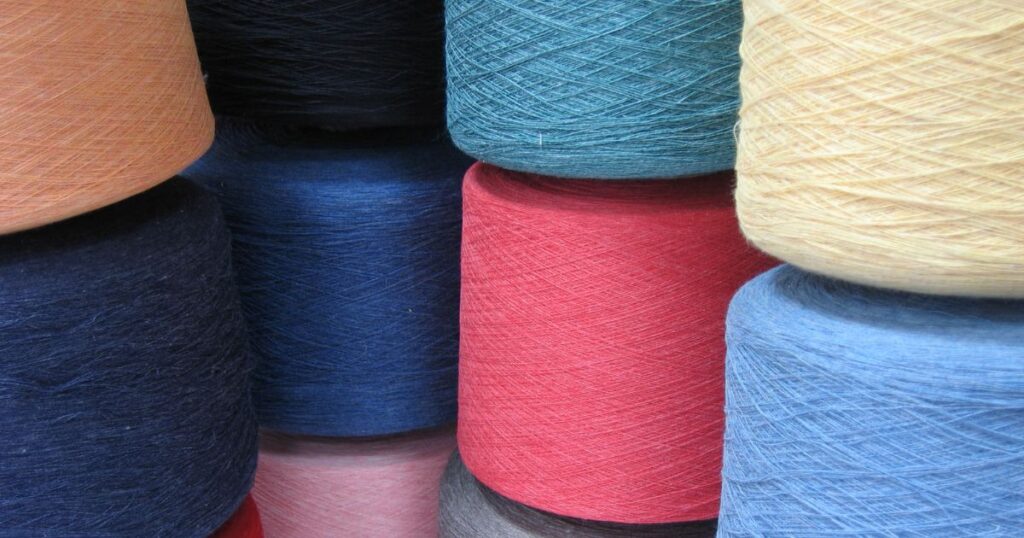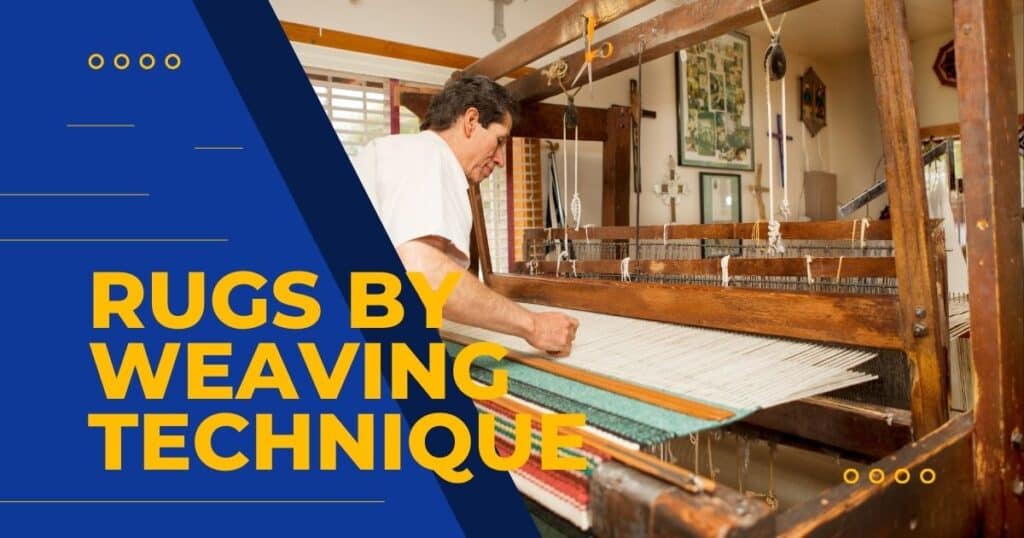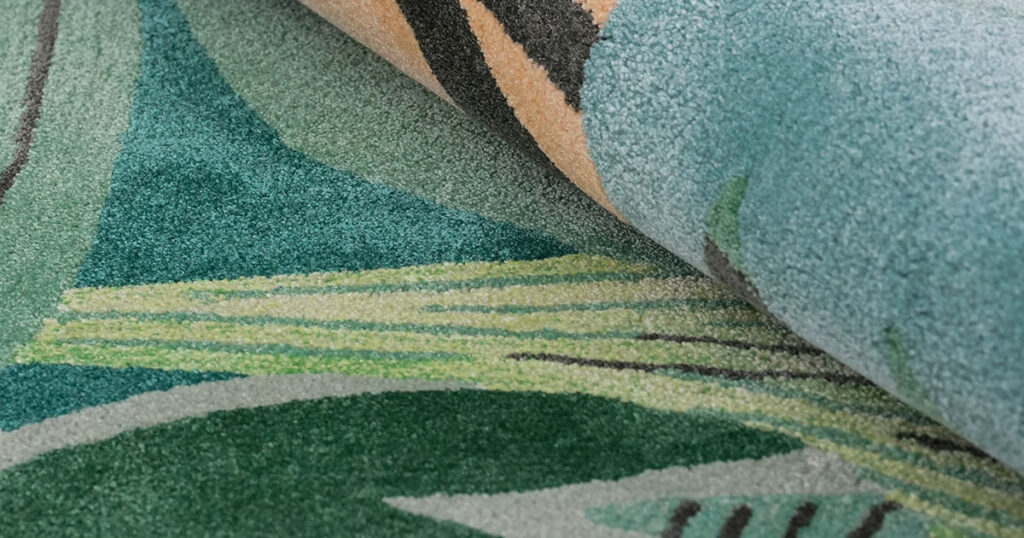This guide will walk you through the essential criteria for evaluating potential tufted rug makers.
Highlight key differences between commercial and residential requirements.
And share valuable tips to ensure your custom rug project succeeds.
Why Custom Tufted Rugs?
Before diving into selection criteria, it’s worth understanding why tufted rugs are so popular for commercial settings.
- Tufted rugs dominate the commercial market (90-95% of commercial carpets).
Because they offer faster production and lower costs while allowing for custom designs.
They’re versatile enough for various business environments from hotel lobbies to corporate offices.
Checklist for Evaluating a Maker
When reviewing potential manufacturers, use this comprehensive checklist to ensure they can meet your commercial needs:
1. Yarn Quality and Sourcing
Ask specific questions about yarn types and origins.
Quality manufacturers will readily discuss their materials – whether they use premium wool (like New Zealand wool), high-grade acrylic, or specialized blends.
They should also explain how the yarn is dyed (solution-dyed or yarn-dyed), as this affects colorfastness and long-term appearance.
Be wary of any maker who can’t provide clear information about their yarn sources.
This could indicate inconsistent quality that might affect your rug’s appearance and durability.
2. Tufting Technique and Capability
Different commercial settings require different tufting approaches. Verify that the manufacturer can produce the specific style you need – whether hand-tufted with complex patterns or machine-tufted for consistency across larger areas.
Ask about pile options (cut pile, loop pile, or combinations), as the construction dramatically affects both appearance and performance. For high-traffic commercial areas, loop pile often provides better durability, while cut pile offers a softer feel in lower-traffic zones.
3. Design Customization Options
Evaluate how flexible the maker is with customization. Can they match specific brand colors? How many colors can they incorporate in a single rug? What are their capabilities regarding pattern complexity, logos, or text?
For commercial projects involving branding elements, ensure the manufacturer has experience creating precise logo reproductions. Ask to see examples of previous custom work similar to what you need.
4. Sample and Strike-Off Policy
Always request a physical sample before committing to full production. A “strike-off” (a small section showing your pattern and colors) allows you to verify quality, color accuracy, and texture.
Clarify the sample policy:
- Is there a cost?
- Will that cost be credited toward your order?
- What’s the lead time for receiving samples?
Reputable manufacturers understand the importance of sampling and have clear processes in place.
5. Backing and Finishing Details
The backing is crucial for a rug’s stability and longevity.
Ask about backing materials (canvas, synthetic options) and adhesives used (especially important for low-VOC requirements in commercial settings).
Edge finishing is another important consideration – will edges be bound, serged, or hidden?
For custom-shaped rugs, inquire about finishing techniques to ensure clean, durable edges that won’t unravel with heavy use.
6. Durability and Performance
This is perhaps the most critical section for commercial applications. Thoroughly discuss:
- Pile density and weight: Higher density means better wear resistance, especially important in high-traffic areas.
- Tuft bind strength: Good commercial rugs should have strong tuft bind so vacuuming and furniture movement won’t pull out yarns.
- Wear ratings or certifications: Ask about industry classifications like TARR (Traffic Appearance Retention Rating) or European usage level classifications (Class 31-33).
- Fire safety compliance: Confirm the rug meets required flammability standards for commercial spaces (like ASTM E648 in the US or EN 13501 in Europe).
- Stain resistance: Inquire about any treatments or inherent stain-resistant properties, especially for hospitality or food service areas.
A quality manufacturer will provide specific performance metrics rather than vague assurances.
7. Lead Time and Production Capacity
Custom rugs require planning. Get clear timelines for both sampling and full production. If you have a firm deadline (like a store opening), ensure the manufacturer can commit to it.
Also assess their production capacity. Can they handle your volume needs? Could they scale up if your project expands? For large commercial orders, production capacity becomes especially important.
8. Installation and On-Site Considerations
For wall-to-wall installations, ask if the manufacturer handles installation or has certified partners. Even for area rugs, discuss delivery methods and any special handling requirements for large pieces.
Request maintenance instructions specific to your rug’s construction and materials. This information will help your facilities team properly care for the investment.
9. Safety and Environmental Certifications
Verify that the manufacturer can provide any certifications required for your project:
- Low VOC emissions certifications (like CRI Green Label Plus)
- Sustainability documentation (recycled content, recyclability)
- Anti-microbial treatments (for healthcare or education settings)
These certifications may be required for green building compliance or to meet corporate sustainability goals.
10. Minimum Order Quantity and Size Limits
Confirm that the manufacturer can accommodate your specific project scale. Some large factories have minimum order requirements, while smaller shops might have size limitations.
If your project involves multiple locations or potential future expansion, discuss this upfront to ensure consistent color and quality across orders.
11. Pricing and Payment Terms
Request detailed quotes that clearly outline what’s included. Understand payment terms, deposit requirements, and cancellation policies. Be cautious of manufacturers requiring full payment upfront without a strong reputation.
For commercial projects, also inquire about warranty coverage and what specifically it includes (materials, workmanship, etc.).
12. References and Portfolio
Ask to see examples of similar commercial projects and, if possible, speak with previous clients. Nothing reveals a manufacturer’s reliability like the experiences of past customers.
Look for evidence that they’ve successfully completed projects of similar scale and complexity to yours.
13. Warranty and After-Sales Support
Quality manufacturers stand behind their products. Ask about warranty coverage and what it includes (tuft bind, edge integrity, colorfastness, etc.).
Also inquire about repair services – can they fix damaged areas or refresh worn sections? This can extend your rug’s useful life and protect your investment.
Commercial vs. Residential
When evaluating rug makers, it’s important to understand that commercial and residential rugs have fundamentally different requirements:
Durability & Traffic
Commercial Focus:
Rugs must withstand heavy foot traffic, rolling loads (carts, wheelchairs), and frequent cleaning. This requires high-density tufting and strong fibers (nylon or wool) to prevent crushing and premature wear.
Residential Focus:
While still important, residential rugs face gentler use. Homeowners can choose softer, less dense piles since wear is less intense.
Safety & Code Compliance
Commercial Focus:
Commercial rugs must meet strict fire safety regulations, ADA requirements for accessibility, and anti-slip standards. These aren’t just preferences—they’re legal requirements.
Residential Focus:
Safety remains important but with fewer regulatory demands. Wool’s natural flame resistance is beneficial, but formal fire ratings are rarely required.
Fiber Selection
Commercial Focus:
Performance drives fiber choice. Commercial projects often select commercial-grade nylon or high-quality wool for resilience and soil-hiding properties.
Residential Focus:
Comfort and aesthetics often take priority over extreme durability, allowing more flexibility in material selection.
Customization & Design
Commercial Focus:
Branding elements (logos, corporate colors) and practical considerations (soil-hiding patterns) typically drive design decisions.
Residential Focus:
Personal style dominates, with fewer practical constraints on color choices or patterns.
Maintenance Requirements
Commercial Focus:
Rugs must withstand daily vacuuming and regular professional cleaning. Stain resistance and ease of maintenance are critical.
Residential Focus:
Less frequent, less intensive cleaning means more material options are viable.
Scale and Installation
Commercial Focus:
Projects often involve very large rugs or wall-to-wall installations requiring professional installation.
Residential Focus:
Typically involves standalone rugs that can be delivered and placed without specialized installation.
Cost Considerations
Commercial Focus:
Investment decisions typically weigh initial cost against expected lifecycle and replacement timing.
Residential Focus:
Decisions more often balance personal preference with budget without the same ROI calculations.
Understanding these differences helps you communicate your needs clearly and ensure manufacturers are approaching your project with the right commercial mindset.
Additional Tips
Educate Yourself on Construction Types
Tufted rugs are just one construction method. Understanding the basics of alternatives (woven, hand-knotted, etc.) helps you appreciate why tufting is being chosen and when another method might be more appropriate despite higher cost.
Plan for Maintenance from Day One
A beautiful custom rug can deteriorate quickly without proper care. Discuss maintenance requirements with potential manufacturers and ensure their recommendations align with your facilities team’s capabilities.
Establish cleaning protocols before installation: vacuuming frequency, spot cleaning procedures, and professional deep cleaning intervals will all extend your rug’s life.
Expect Some Variations
Hand-tufted products naturally have slight variations. Minor differences in tuft height or line smoothness are normal and part of the charm of custom pieces. Set realistic expectations about the handcrafted nature of custom rugs.
Inspect Thoroughly Upon Delivery
When your rug arrives, conduct a detailed inspection before installation. Check:
- Dimensions match specifications
- Colors match approved samples
- Pattern execution is correct
- Edges and backing are properly finished
- Tuft bind is secure (gently tug at fibers – none should pull out easily)
Report any issues immediately, as reputable makers will want to address problems promptly.
Consider Rug Pads and Installation
For area rugs, use quality rug pads to prevent slipping and add cushioning. For wall-to-wall installations, ensure installers properly stretch and secure the carpet according to manufacturer recommendations.
Plan for Future Needs
If your project might expand or require matching pieces later, inform the manufacturer upfront. They can keep records of designs and dye formulas. For high-profile areas, consider ordering spare rugs for rotation or replacement.
Account for Shipping and Import Costs
When working with international manufacturers, remember to budget for shipping, customs, duties, and potential delays. Ensure the quoted price clearly states what shipping terms apply (FOB, CIF, DDP, etc.).
Balance Trends with Longevity
Consider how long you expect the rug to remain in service. Trendy patterns might feel dated quickly, while more timeless designs offer greater visual longevity. Many commercial designers choose abstract patterns and rich colors that age well and hide soil effectively.
Maintain Complete Records
Keep files with all specifications, drawings, color references, and communications. These records prove invaluable for future matching or if issues arise. Also retain care instructions and warranty information for the facilities team.
Making Your Final Decision
After evaluating potential manufacturers using the checklist and understanding the commercial-specific requirements, you’ll be well-positioned to select the right partner for your custom tufted rug project.
The best choice often balances:
- Quality and performance appropriate for your specific setting
- Design capabilities that match your branding needs
- Production capacity scaled to your project timeline
- Transparent communication about materials and processes
- Fair pricing with clear terms and reasonable payment structure
- Proven track record with similar commercial projects
Remember that the lowest bid isn’t always the best value.
Consider the total cost of ownership, including expected lifespan, maintenance requirements.
And the manufacturer’s ability to stand behind their product.




